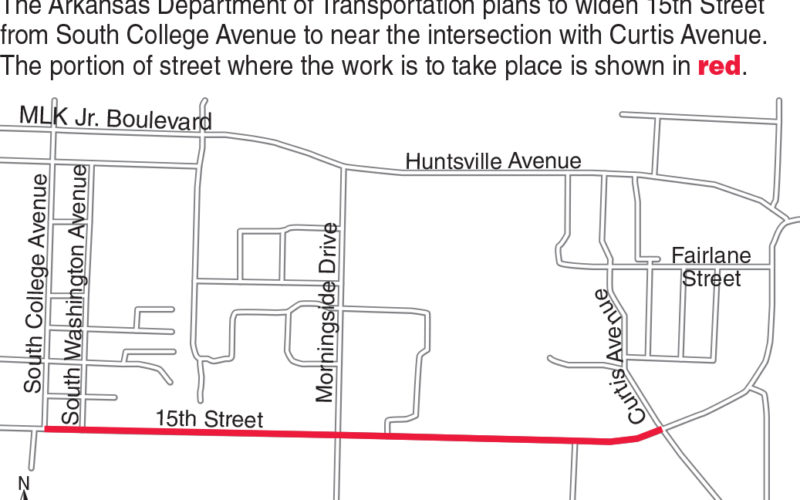Fayetteville gears up for highway widening
STACY RYBURN
sryburn@nwadg.com
Dirt could be moving by the end of the year on a widening project that has been on the state’s to-do list for a decade.
The Fayetteville City Council last week signed off on an agreement with the Arkansas Department of Transportation to move water and sewer lines along 15th Street. The majority of the work will be from South College Avenue east to the intersection with Curtis Avenue.
The lines need to be moved to make room for widening 15th Street to four lanes for vehicles, along with bicycle lanes and sidewalks. A section from the Curtis Avenue intersection east to Happy Hollow Road has been done. One piece of Happy Hollow Road up to Huntsville Road has been widened but awaits sidewalks and some utility relocations.
Fifteenth Street is a part of Arkansas 16, which becomes Huntsville Road to the east. Discussion of improving Arkansas 16 began about the time of the city’s previous bond issue in 2006, said Chris Brown, city engineer.
The state widened some of the highway, such as Huntsville Road from Happy Hollow to Stonebridge roads. Costs escalated as time passed, and finishing the work was put on hold Brown said.
“Eventually, it came back up to the priority list for the Highway Department,” he said.
Arkansas 16 from Baum-Walker Stadium to Crossover Road serves as the southern side of the so-called “mayor’s box” around the city. Mayor Lioneld Jordan made it a priority once in office to create a continuous traffic loop, with major thoroughfares at the northern, eastern, southern and western edges of the city.
The only segment missing is a portion of Rupple Road from Tanyard Drive to Weir Road, which is under development. Other stretches of road received overhauls to accommodate cars, bicycles and pedestrians.
About 6,470 feet of water line and 230 feet of sewer line needs to be moved before the 15th Street widening can begin. The city’s utility map shows the lines mainly run north along 15th Street on the east side, then cross Morningside Drive and run south of the street west to South College Avenue.
Corey Granderson, staff engineer for the city, said he doesn’t anticipate any traffic disruption while the work is done. Water and sewer service also shouldn’t be interrupted. Crews will build the new lines, shut off the old ones and move the flow to the new ones, he said. Property and business owners will be notified of any disruptions.
The agreement between the city and state has the state paying for about 63% percent of the utility moving work. Initial cost estimate is $2.3 million, the state’s share being about $1.5 million and the city paying about $872,000.
However, the money won’t be paid until construction begins, and the cost could change, Granderson said. The percentage of the share between the two entities will remain the same.
Granderson estimated the moving the lines should take 13 to 15 months. Construction should account for six to seven months with easement acquisition and bidding taking the rest. Crews could start moving dirt in about six months, he said.
The state won’t know the full cost and time frame until it goes to bid, said Danny Straessle, Transportation Department spokesman. The widening was tentatively scheduled to begin in November, but moving the utilities has to happen first, he said.
Impact to traffic once the widening begins will be assessed at that time, Straessle said. The public will be notified when project officials have a plan in place, he said.
“We do a lot of highway work in metropolitan areas. Those are typically more challenging because you have denser traffic to maintain while you’re doing the construction,” he said. “Certainly, keeping access open to the adjacent businesses along the route is a priority as well. We’ve got to accommodate that in-and-out traffic.”






